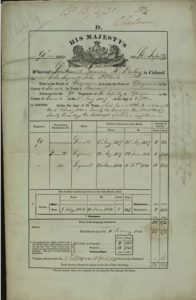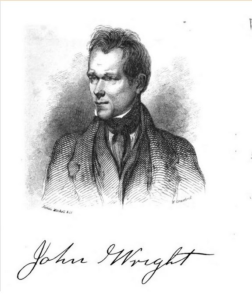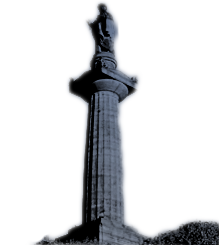Researched and complied by Morag T Fyfe
Military pensioners in Glasgow in the 1840s.
We know that a number of men buried in the Necropolis fought in the Peninsula War or at Waterloo; there are the Cruikshank brothers in Epsilon and Sergeant James Russell of the Scots Greys in Gamma. However, at the moment we are finding that a number of men being buried are described as ‘soldier’, ‘pensioner’, ‘pensioner, late of X Regt’ and it made me wonder whether any of them might be Waterloo veterans. Between 1834 and 1844 24 men have been found. Those listed simply as pensioners may not be Chelsea Pensioners though I do wonder where else their pensions might have come from. Those who are described simply as soldiers may still have been serving in the army when they died but this still leaves a group of 14 ex-soldiers some of whom were awarded pensions when they left the army. Ignoring the five officers at the moment I was left with nine names.
A quick search of the Waterloo Medal Roll showed that none of the men could be identified there but I may have managed to find the service records of four of them in the other online military records at Ancestry and Find my Past. It can be a problem being sure that one has found the correct records but I am reasonably confident that, in this case, I have identified the correct John Pollock who was buried in the Necropolis on 17th October 1842. This John Pollock, agent and house factor late of 90th Regt was buried in Eta 16, the only one of the sample not to be buried in a Single Grave. His age was given as 51 from which one can estimate his year of birth as 1790-1791.
His service records show John Pollock joined the 90th Regiment at Glasgow in 1807 at the age of 18 and was discharged from Haslar Barracks, Gosport in 1831 as a colour sergeant. When he left the regiment he was the Pay-Sergeant for his company which suggests a certain level of education and probably explains why he was able for find employment as an agent and house factor when he returned to civilian life.

John Pollock – Service Records
His service is listed as six years in the West Indies where he was present at the surrender of Guadeloupe by the French in 1810, one year in North America [Canada], six months in France and three years in the Mediterranean. When Pollock enlisted in 1807 the 90th was already in the West Indies stationed on Saint Vincent and Pollock arrived there on 9th July 1808. The regiment left for Canada on 20th June 1814 and moved from there to Ostend in August 1815 to form part of the Army of Occupation of France; thus Pollock missed participating in the Battle of Waterloo by two months. The regiment spent 1820-1830 in the Mediterranean but Pollock only spent three years there and the reason becomes clear when one reads about his medical state. Before being discharged he had to go before a medical board who certified that he was suffering from ‘hepatic disease’ and chronic rheumatism. His ill health was agreed to stem from a ‘protracted attack of remittent fever at Zante in 1824’. Zante, or Zakynthos is one of the Ionian Islands where the regiment arrived in 1821. Remittent fever is a symptom, not a disease in itself so it is impossible to know for sure what Pollock was suffering from but malaria or typhoid fever may be likely. Bearing in mind Pollock only served in the Mediterranean for three years it looks as though he returned to Britain after his illness in 1824.
There is no longer a gravestone on Eta 16 but the burial registers record the burial of Margaret Wright, relict of John Pollock in 1843.
Bleachfields – William Adam of Milnbank
On the 31st October 1843 William Adam of Milnbank Bleachfield was buried in the Necropolis. His coffin was originally placed in the Egyptian Vaults until his grave in Kappa was ready. On reading this entry I wondered where this bleachfield was and assumed it was probably south of Glasgow near Giffnock or Thornliebank. I was rather surprised to discover that it lay about a fifteen minute walk north-east of the Necropolis between the Molendinar Burn and the Monkland Canal.

Extract from 1st edition of 6 inch Ordnance Survey map showing Milnbank and Burnbank. (NLS Creative Commons Attribution-NonCommercial-ShareAlike (CC-BY-NC-SA) licence. https://maps.nls.uk/index.html)
A William Adam, bleacher, first appears in the Glasgow directory for 1828-29 where he is found at Burnbank Bleachfield while two years later he has moved slightly west to Milnbank. This William Adam is probably the same person as the William Adam bleacher at Milnbank whose trust disposition and inventory were registered at Glasgow Sheriff Court on 22nd January 1835 suggesting he died late in 1834 and is probably the father of our William Adam buried in 1843. In the Post Office directory for 1830-31 not only is William Adam shown as located at Milnbank but the firm of William Adam and Son of Milnbank makes its first appearance. This firm can be traced in the Post Office directories at Milnbank until the last online directory of 1910-11 but I do not know what its history is after that.
The Adam of Milnbank family finished up with three lairs in Kappa and two in Epsilon. There are at least thirty three members of the wider family buried or commemorated in the Necropolis between 1836 and 1968.
Bonnetmakers and dyers – Trades incorporations
The Necropolis was established by the Merchants House of Glasgow but there is also a Trades House which is home to the fourteen incorporated crafts of Glasgow. Like the Merchants’ House it has lost much of its original purpose but remains an important charitable organization. One of our members, who belonged to the Bonnetmakers and Dyers Incorporation, recently asked whether we knew of any members of that craft buried in the Necropolis. A quick search did not turn up anyone and it became obvious that, although many of the men buried in the Necropolis must have been members of one or other of the craft incorporations, this fact was not normally recorded on the gravestone. I did manage to identify two members of the craft by dint of checking the most prominent members of the craft like the Deacons and found Sir Matthew W Montgomery, LLD, DL, Lord Provost of Glasgow 1923-26 and Sir Andrew Hislop Pettigrew, DL, LLD of Pettigrew & Stephens of fond memory.
John Wright of Galston, poet

Taken from The whole poetical works of John Wright … with a portrait of the author, and a sketch of his life, 1843.
A number of early nineteenth century poets can be found in the Necropolis. Dugald Moore, William Motherwell, and Alexander Rodger are all commemorated by gravestones but John Wright was laid to rest in an unmarked Single Grave in compartment Iota on 23rd May 1844. Wright was born in Sorn parish in 1805 and moved to Galston, his father’s home town, as a young child. His formal education only amounted to a few months and he did not learn to write until in his teens. His long poem ‘The Retrospect’ was published in 1830 with the encouragement of Professor John Wilson (Christopher North of Blackwood’s Edinburgh Magazine).
He married in 1832 and had several children but by 1841 he had abandoned his family. Judging by the memoir that prefaces the collection of his poems published by his friends in 1843, The whole poetical works of John Wright … with a portrait of the author, and a sketch of his life Wright may have suffered from some form of mental illness exacerbated by heavy drinking. He died from bronchitis, probably in the Royal Infirmary if we take at face value the fact that one of the men who arranged his funeral was Mr Brown of the Royal Infirmary.
A new profile has been added to the website, for Humphry Ewing Crum Ewing and family buried in compartment Beta. Crum Ewing was the nephew and heir of James Ewing of Strathleven one of the founders of the Necropolis.
******************************
Anyone who would like to help with this indexing project is very welcome to join us by contacting me at morag.fyfe@ntlworld.com









